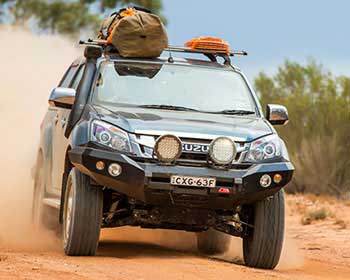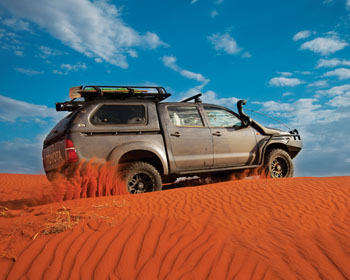4WD Accessories - What You Really Need

These days, there are more 4WD accessories on the market than ever before. Not only are the number of options huge, but there are so many manufacturers making them too. If you want an inverter to run your coffee machine in the back of your 4WD, a winch that you can control with your mobile phone or a lithium ion battery bank to run your electrics, you can have it without any dramas in the world (except funding it!).
Every year new accessories are designed, and the existing ones are improved. It’s a never ending cycle, and no doubt in 10 years’ time the number of 4WD accessories available will be staggering.
The thing is though, what do you really need?
We’ve done a heap of travelling around Australia. I’ve seen every vehicle imaginable out on the tracks - ranging from $500 bangers through to your top of the range Iveco Daily 4WD trucks and everything in between.
The irony though, is many of those that have travelled large amounts of Australia do not have an excessive accessory list. Sure, there are plenty of vehicles out there travelling with a long list of modifications and accessories, but the large majority don’t.
That would make it pretty clear then, that you don’t need every accessory under the sun to get out there and explore this fantastic land of ours.
The history of travelling in Australia
4WDs only really started to become more common in the mid-1960s, with farmers and industry taking up a large number of the purchases. As time went on, the number of 4WDs sold has steadily increased.
However, before there were 4WDs, people still travelled Australia. They did it in basic 2WD vehicles, and although times would have been tough, they got the job done. If anything, the condition of travel has become easier over time due to bitumen roads and better road maintenance. The point I make is this; any reasonably modern 4WD today is miles in front.
Australia is a tough place
I don’t for a minute mean to recommend underprepared 4WD adventures; Australia is a harsh place in many regions. If you are underprepared things can go badly wrong, and they do every year. Most often it happens to those with little experience, who head out without truly appreciating the size and how harsh Australia can really be at times.
You should be prepared, with the right gear available and the relevant understanding of what to do should something go pear shaped.
What is the purpose of 4WD accessories?
4WD accessories are expensive, and being careful about what you spend your hard earned money on is an important step. Ultimately, the idea is to build a 4WD up that does what you want it to. That will probably be different to the bloke next door and your work colleagues, and that’s just fine. At the end of the day, you are using it, and if it doesn’t do what you want it to, what’s the point?
When adding 4WD accessories, consider these four things:
Reliability – Does the accessory increase reliability?
Functionality – Does the accessory make your 4WD more functional for the way you use it?
Comfort – Will the accessory make your time in or with the 4WD more comfortable?
Is it worth it? – This is the final piece of the puzzle. You can spend a fortune on accessories, and you’ll probably never recover it. Would you be better off putting that money towards fuel and having several great trips away instead? Only you can make that call!
4WD accessories that you need
Quality tyres
Tyres are crucial in a 4WDing application. Sharp stones, low tyre pressures, rocks and endless corrugations are just a few of the things a tyre has to put up with in its lifetime. A flat tyre out in the bush is at best an inconvenience, but it can be much more serious than that.
The tyres that come with a brand new 4WD are not suitable for off road use (except basic beach driving). Ironic, isn’t it? They are designed to be quiet, fuel efficient and to handle well on the bitumen.
Before you head out anywhere remote, you should be replacing your tyres with a set of light truck tyres, which are designed for the rigours of the Australian bush. Match your terrain to the tread pattern; All Terrain tyres are most common, but if you do a lot of mud driving then muddies are a great alternative.
Rated recovery points
You will get stuck, eventually. It’s part of owning a 4WD. When you do, you need safe points that you can be recovered from, not the tow points that most 4WDs come with from the factory. Look for the Safe Working Load (SWL) and grade 8.8 bolts to confirm its all in order.
Recovery gear
4WDs won’t recover themselves; you need the right gear to get yourself out if you are solo, or enough gear to get moving again if you are travelling with someone else. Snatch straps, shackles, a long handled shovel, traction boards, winch extension strap etc. are all very useful bits of gear to have in your 4WD.
Suitable suspension
There are plenty of gravel roads in Australia that will push your suspension to the limit. Corrugations especially, can have your shock absorbers running easily over 100 degrees Celsius. Suspension works seriously hard off road, and you want a setup that is going to last. The factory suspension can be acceptable if it’s in good condition, you are not heavily loaded and the track isn’t bone breaking.
However, a quality aftermarket suspension set will handle better, and keep cooler when the going really gets tough.
Compressor and air gauge
Tyre pressures are the most critical factor you can control in a 4WD. You must be able to deflate your tyres for the terrain you’re on, and pump them back up when you are done.
Safety
A first aid kit should be in every 4WD taken out bush. If something does go wrong, you don’t want to be wasting time.
Having a way to communicate is imperative. Whether it’s a UHF radio, satellite phone, GPS tracker or HF radio, match your communication arrangement to how you are travelling.
A cargo barrier is imperative too; should you be involved in an accident it stops the gear in the back of your 4WD coming forward and hitting the driver or passengers.
Frontal protection
In Australia, kangaroos and cattle are common once you leave the city. A bull bar offers the required protection to get you back to civilisation safely.
Driveline breathers and a snorkel
If you are doing any water crossings, breathers for your differentials, transfer case and gearbox are really important. They are relatively cheap, and can save you an absolute fortune when things go wrong.
Optional 4WD accessories
From there, the list of accessories you can fit to a 4WD are endless, starting with storage upgrades like drawer systems, then dual batteries, solar, a winch, long range tank, roof rack, rear bar, underbody protection, rock sliders and the list goes on and on.
Only you can decide what you should fit to a 4WD, but don’t believe that you need every accessory under the sun to travel Australia safely.
What accessories do have in your 4WD? Let us know in the comments below or join the conversation on Facebook.

These days, there are more 4WD accessories on the market than ever before. Not only are the number of options huge, but there are so many manufacturers making them too.

